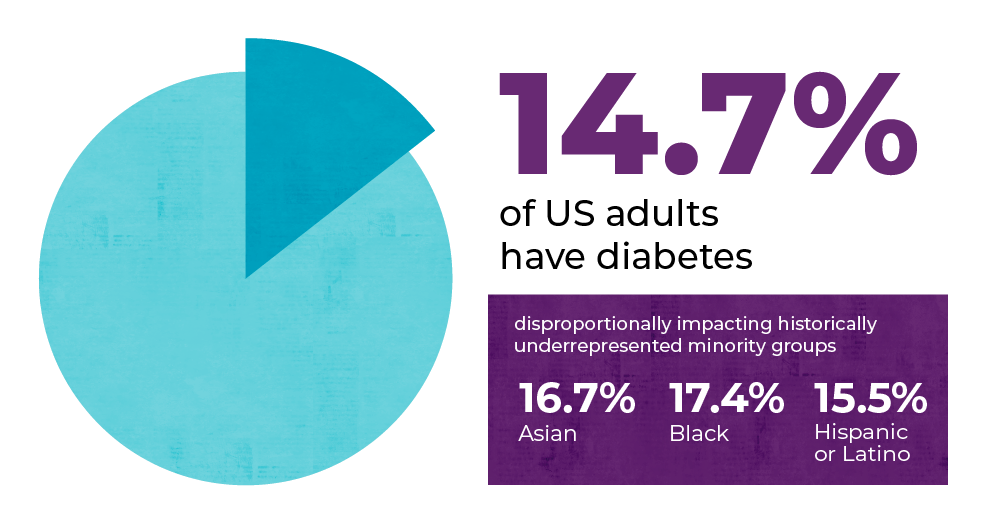Introduction
Welcome to FHI 360’s toolkit for food banks interested in implementing community-based diabetes programs! This resource is designed to help food banks assess whether they are ready to start diabetes programming and, if so, provide guidance on how to prepare for, implement, and evaluate those programs. Click the tabs at the top of this page for guidance on each stage of providing a diabetes program. Throughout the toolkit, tabs in the right sidebar provide information on specific topic areas.
Food banks may provide the following diabetes programs:
- Food-based programs, like those offering tailored food packages for people with diabetes
- Education and support programs, like those providing diabetes self-management education and support (DSMES) services
- As defined in the DSMES Toolkit, “DSMES provides an evidence-based foundation to help people with diabetes navigate their condition. This includes daily self-management decisions to manage blood sugar, improve overall health, and prevent or delay diabetes complications.”
- Programs combining food with education and support
Who is this toolkit for?
This toolkit is based on findings from a project that evaluated diabetes programs implemented at food banks. The primary audience is staff at food banks that are considering implementing diabetes programs. The resources may also be helpful for food banks that already have diabetes programs in place or for other types of community organizations interested in implementing diabetes programs.
Why should food banks consider providing diabetes programs?
- High Need in the Food Bank Community: Over 38 million Americans live with diabetes, and those facing food insecurity are particularly impacted.1 Food banks, with their established trust and relationships within communities experiencing food insecurity, are uniquely positioned to help individuals with diabetes manage their condition more effectively.
- Organizational Capacity: Studies have shown that food banks can successfully provide programs for people with diabetes, including diabetes-tailored food packages and DSMES services.2,3 Food banks often have existing resources like food distribution infrastructure and staff with expertise in nutrition, making them uniquely well-suited to provide such services.
- Mission Alignment: By incorporating diabetes programs, food banks can directly address a significant health issue that disproportionately affects their clients, often aligning with their broader mission of improving health and wellbeing in the community.
“In addition to our food pantry, we provide different services related to nutrition education…where we’re providing nutrition, health, and wellness resources to promote healthier eating and healthier living through our programs.”
— Diabetes program implementer
Project Background
The resources on this website were informed by learnings from a project funded by the Centers for Disease Control and Prevention (CDC) that evaluated DSMES services and food-based programs provided by a Texas food bank. The project also included interviews with six food banks across the country to understand their experiences with diabetes programs and what types of resources would help them implement new diabetes programs.
People interested in learning about the study, or the data generated from it, can contact studyinfo@fhi360.org to request more information.
Diabetes 101
- Food insecurity has been shown to increase risk for type 2 diabetes and, for individuals who have diabetes, is associated with poorer blood sugar control.1
- In 2022, diabetes generated an estimated $412.9 billion in total costs in the United States, including $306.6 billion in direct medical costs and $106.3 billion in indirect costs.4
- People with diabetes who are able to control their blood sugar can lower their risk for short-term complications and long-term damage to vital organs, significantly impacting quality of life and reducing risk of death.5,6
- For more information on diabetes, please see Other Resources below.

Other Resources
Diabetes Information:
- Centers for Disease Control and Prevention: Diabetes
- Centers for Disease Control and Prevention: National Diabetes Statistics
DSMES Information:
- Association of Diabetes Care and Education Specialists (ADCES)
- American Diabetes Association (ADA): Education Recognition Program
Information about Addressing Diabetes Through Food Banks:
- Feeding America: Hunger and Health
Citations
1 Levi R, Bleich SN, Seligman HK. Food insecurity and diabetes: overview of intersections and potential dual solutions. Diabetes Care. 2023 Sep 1;46(9):1599-1608.
2 Seligman HK, Smith M, Rosenmoss S, Marshall MB, Waxman E. 2018. Comprehensive diabetes self-management support from food banks: A randomized controlled trial. American Journal of Public Health 2018 Sep;108(9):1227-1234.
3 Seligman HK, Lyles C, Marshall MB, Prendergast K, Smith MC, Headings A, Bradshaw G, Rosenmoss S, Waxman E. A pilot food bank intervention featuring diabetes-appropriate food improved glycemic control among clients in three states. Health Affairs. 2015 Nov 1;34(11):1956-63.
4Parker ED, Lin J, Mahoney T, Ume N, Yang G, Gabbay RA, ElSayed NA, Bannuru RR. Economic costs of diabetes in the US in 2022. Diabetes Care. 2024 Jan 1;47(1):26-43.
5Cavero-Redondo I, Peleteiro B, Álvarez-Bueno C, Rodriguez-Artalejo F, Martínez-Vizcaíno V. Glycated haemoglobin A1c as a risk factor of cardiovascular outcomes and all-cause mortality in diabetic and non-diabetic populations: a systematic review and meta-analysis. BMJ open. 2017 Jul 1;7(7):e015949.
6Stratton IM, Adler AI, Neil HA, Matthews DR, Manley SE, Cull CA, Hadden D, Turner RC, Holman RR. Association of glycaemia with macrovascular and microvascular complications of type 2 diabetes (UKPDS 35): prospective observational study. BMJ. 2000 Aug 12;321(7258):405-12.

